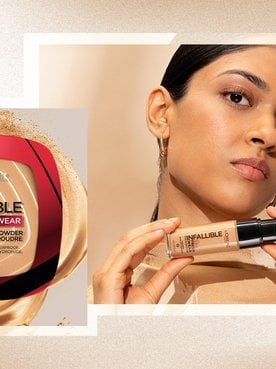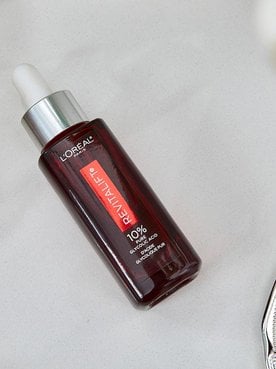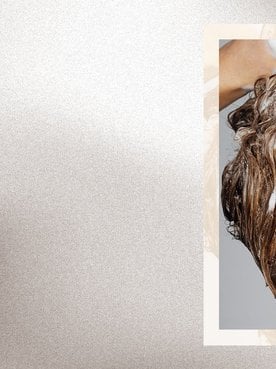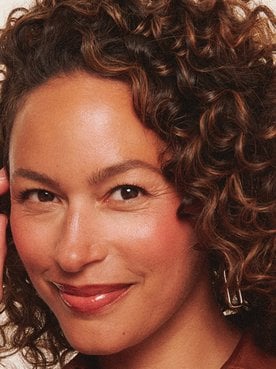Hair porosity (or hair’s capacity to hang onto moisture) is an important yet often overlooked aspect of caring for your mane. While dedicated formulas exist for different hair types, damage levels, and even colors, not many are geared toward the specific needs of low vs. high porosity hair.
For some quick background, every strand on your head is porous to some extent, but porosity can differ greatly from one person to the next. Your hair’s porosity level can (and should) influence the products you use and when you use them. Ahead, discover the meaning of porosity and how learning yours can help guide you toward your best hair yet.
What Is Hair Porosity?
Simply put, hair porosity refers to your hair’s ability to absorb and retain moisture. Porosity is usually determined by the condition of your hair’s cuticle layer (or the outermost layer of the hair shaft) and can be classified as low, medium, or high.
Much like your skin, your hair also has pores—although not the same type. Think of the pores on your strands like shingles on a roof. If your shingles are lifted or “open,” water can get through, which means your hair is probably highly porous. Conversely, if your shingles lie flat and smooth, water can’t get through, resulting in low porosity hair. As can be expected, medium porosity hair falls somewhere in the middle.
Here’s a more comprehensive breakdown of each level of hair porosity and their common characteristics:
- High porosity hair: Highly porous hair often has gaps and holes in the cuticle layer, frequently due to damage. High porosity hair typically absorbs moisture quickly but loses it just as fast, leading to issues with dryness, brittleness, and frizz.
- Medium porosity hair: Hair with medium porosity usually has a slightly raised cuticle layer, allowing for moderate absorption and retention of moisture. You may notice that your styles hold up fairly well and that your hair is resistant to damage, even after coloring or heat styling.
- Low porosity hair: This type of hair generally has a tightly bound cuticle layer, which can be a double-edged sword. On one hand, your hair is typically smooth and shiny. On the other, a tight cuticle can make it difficult for water, moisture, and haircare products to penetrate properly. As a result, you may experience product buildup and have a hard time adequately hydrating your hair.
Is low or high porosity hair better?
It’s important to note that neither high nor low porosity is inherently "better" than the other. Identifying your hair porosity is simply helpful in figuring out how to give your mane what it needs to look (and feel) its best.
What Influences Hair Porosity?
Innate factors like aging and genetics can both contribute to highly porous hair, but how you care for your hair can also make a difference. According to a study published in the International Journal of Trichology, all hair is porous, but damaged hair is even more so. Heat, UV exposure, and chemical processing (like bleaching your strands) can greatly impact your hair’s porosity levels, per the Journal of Cosmetic Science. To help avoid damaging your strands, consider limiting chemical treatments and hot tool usage. And, when heading outdoors, protect your hair from the sun with UV-protective haircare products, a wide-brimmed hat, or a head scarf to help reduce potential damage.
How To Conduct a Hair Porosity Test
By now, you may be asking yourself, “How do you know your hair porosity?” The truth is that there isn’t a definitive way to determine how porous your hair is. However, a few at-home hair porosity tests can help you make an educated guess.
The first is the float test. Take a few clean strands of hair (you can pluck a piece from your hair brush instead of ripping it from your head) and drop them into a glass of room-temperature water. If the strands immediately sink to the bottom, your hair is probably highly porous. Low porosity hair, meanwhile, will float on top of the water, not absorbing much (or any) of it. If your hair floats for a minute or two before sinking, you may have medium porosity hair that’s a mix of both.
The second option to gauge whether you have low vs. high porosity hair is with the spritz test. Just spray some water onto your hair when it’s dry and observe how fast it absorbs. Highly porous hair will soak it up right away, while medium porosity hair will draw it in relatively quickly. With low porosity hair, the water will typically bead up on the surface before (very slowly) sinking in.
How to Care for High Porosity Hair
If the results of your hair porosity test point to having extra porous hair, don’t panic: there’s plenty you can do to help protect and nourish your strands. We’re sharing a few tips below.
1. Opt for hydrating products
Replenishing and locking in moisture can help your highly porous hair look and feel its best. To give your mane the best possible chance at retaining moisture, start at the beginning of your routine with a moisturizing shampoo and conditioner system.
We love the L’Oréal Paris Elvive Hyaluron + Plump Hydrating Shampoo and L’Oréal Paris Elvive Hyaluron + Plump Hydrating Conditioner. When used in conjunction, this castor oil and hyaluronic acid-infused range helps re-plump dry, dehydrated hair for up to 72 hours for shiny, free-flowing results.
If you have wavy to coily hair, you could also try the L’Oréal Paris Elvive Dream Lengths Curls Moisture Push Shampoo and L’Oréal Paris Elvive Dream Lengths Curls Moisture Seal Conditioner, which help hydrate, shape, and define curls for a frizz-free mane.
Shop the Products
2. Reach for a hair mask
For added hydration, consider using a deep-conditioning hair mask once weekly or whenever your hair could use extra TLC. We love L’Oréal Paris EverPure Sulfate Free Simply Clean Elastic Fiber Masque. This nourishing hair mask envelops hair in intense, essential moisture to renew softness and shine. Apply it to clean, damp hair and let it sit for five minutes before rinsing and styling as usual.
Shop the Product
3. Never skip heat protectant
Using hot tools consistently can be a big no-no when dealing with highly porous hair. You can still use hot tools to perfect your look—just be sure to set your tools to their lowest temperature setting and apply a heat protectant to protect your strands. We like the L’Oréal Paris EverPure Sulfate-Free Weightless Blow Dry Primer, which protects hair from heat up to 450 degrees Fahrenheit and offers 48 hours of frizz control.
Shop the Product
4. Use the ‘LOC’ styling method
As previously mentioned, highly porous hair has open cuticles that can make retaining moisture difficult. One way to keep this moisture in the hair is by following the LOC method. This technique represents the order (liquid, oil, cream) in which hair products should be applied to help maximize moisture retention.
To start, saturate your hair with water or apply a water-based leave-in conditioner to help fill your strands with moisture. Then, apply an oil, which can help create a barrier over your strands to keep that water from escaping. Per a study published in the NCBI, oils and serums with castor oil, jojoba oil, or argan oil are proven to help seal moisture in your strands. Try L’Oréal Paris Elvive Dream Lengths Frizz Killer Serum Leave-In, which is formulated with castor oil, to tame frizz and help protect hair from heat damage. Finally, apply a cream product (like L’Oréal Paris Elvive Dream Lengths Curls Leave-in Conditioner) to further lock in long-lasting moisture and help hydrate the exterior of your hair.
Shop the Products
How to Care for Medium Porosity Hair
Medium porosity hair is generally easy to manage. It typically has a balanced cuticle layer, allowing for moderate moisture absorption and retention. Making good choices in your haircare routine is the best way to help maintain its healthy look and feel.
1. Use bond-repairing products

Excessive hair damage can bring medium porosity hair right into high porosity territory. If you color, heat style, or chemically service your hair, consider introducing bond-building products—like those in the L’Oréal Paris EverPure Bond Repair collection—into your haircare routine to keep damage to a minimum.
This system (which includes the L’Oréal Paris EverPure Bond Strengthening Pre-Shampoo Treatment, L’Oréal Paris EverPure Sulfate-Free Bond Repair Shampoo with Citric Acid, and L’Oréal Paris EverPure Sulfate-Free Bond Repair Conditioner with Citric Acid) penetrates deep into hair’s cortex to help reinforce hair’s natural structure. The line also boasts smoothing and detangling benefits, which may help prevent future damage.
Shop the Products
2. Prioritize moisture
Medium porosity hair doesn’t always require reparative treatments to keep it in optimal shape. Some days, moisture may be all you need to keep hair soft, smooth, and manageable. In that case, add the L’Oréal Paris EverPure Sulfate Free Frizz Defy Shampoo with Marula Oil and L’Oréal Paris EverPure Sulfate Free Frizz Defy Conditioner with Marula Oil to your in-shower lineup to help deeply condition your hair and keep it protected against humidity.
Shop the Products
3. Be wary of over-washing
Medium porosity hair tends to maintain a good balance of natural moisture and oils. Therefore, you don’t want to over-shampoo your hair and risk making it feel stripped and dry. How often you lather up ultimately depends on things like your lifestyle, hormones, and climate, but two to three times a week is generally a good rule of thumb. If you find yourself dealing with greasy hair between wash days, mist your roots with a dry shampoo to help reduce the appearance of oiliness.
4. Detangle gently
Gently detangling medium porosity hair is essential to keep breakage at bay. Start by saturating your hair with a lightweight conditioner or detangling spray to help add slip to your strands. Then, use a wide-tooth comb to carefully work through any knots or tangles, starting from the ends and gradually working up toward the roots. Try to avoid yanking or pulling at stubborn knots, as this can lead to breakage. If you encounter particularly stubborn tangles, apply more conditioner or detangling spray and allow it to sit for a few minutes before gently attempting the detangling process again.
How To Take Care of Low Porosity Hair
Low porosity hair may appear silky and shiny at first glance, but in actuality, it can be prone to dryness and buildup. The good news, though, is that once moisture and haircare products are in, they’re less likely to escape. Here’s what you’ll need to do to keep your hair in great shape.
1. Use a clarifying pre-shampoo treatment
A clarifying pre-shampoo can help remove product buildup on low porosity hair. As its name indicates, a pre-shampoo treatment is a product designed to be applied to the hair (and, often, the scalp) prior to shampooing to help target specific hair woes. We’re partial to the L’Oréal Paris Hair Elvive Hyaluron + Pure Oil Erasing Serum for Oily Hair, which helps clarify the hair and scalp and provides 72 hours of hydration before the hair-washing process begins.
Shop the Product
2. Use the ‘LCO’ styling method
Whereas those with high porosity hair are generally advised to apply liquids, then oils, then creams, low porosity hair benefits from a slightly different approach. The LCO method involves flip-flopping the order of your oil and cream so that you’re applying everything from lightest to heaviest (liquid, cream, oil). This minimizes the chances of products sitting on your hair's surface and instead allows them to sink in as intended.
Start with a liquid-based leave-in conditioner like the L’Oreal Paris Elvive Hyaluron + Plump Moisture Plump Serum to help introduce hydration to your strands without weighing them down. Then, follow it up with a lightweight, nourishing hair cream to deliver intense moisture sans any heavy-feeling residue. Finally, finish your LCO routine with a hair oil or thicker serum to seal in all the moisture you just added to your strands.
Shop the Product
3. Experiment with hair steaming
Theoretically, exposing your hair to moist heat, typically using a handheld or hooded steamer, can help open the hair’s cuticle so that low porosity hair can absorb more moisture.
After shampooing, apply your favorite conditioner or hair mask. Then, cover your head with a shower and let your preferred method of steam envelop your hair for 15 minutes before rinsing. If you don’t have a dedicated hair steamer on hand, slip on a shower cap and place a hot hand towel over it (wrung of water but slightly damp). Then, add another cap on top of the towel and let the warmth encase your hair until the towel goes slightly cold. While there’s no conclusive proof that steaming your strands can help moisturizing products penetrate deeper, it can’t hurt to try—just be sure the steam isn’t so hot that it burns your scalp.
Next Up: How To Fix Damaged Hair
Photo Courtesy of L'Oréal Paris







